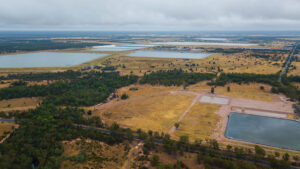Next-Generation Technology: This is why water processing will be big business for Parkway Minerals

Pic: Schroptschop / E+ via Getty Images
Special Report: A landmark partnership deal with engineering giant Worley has been signed and collaboration with several prospective clients ongoing. 2020 is shaping-up as the year Parkway Minerals’ (ASX:PWN) revolutionary brine processing technology portfolio moves out of the lab and on to the big stage.
250 billion litres of unusable waste brines (salty water) is produced globally every single day.
That’s about 30 litres of waste brine for every man, woman, and child at a time when access to freshwater is becoming increasingly challenging.
For the mining sector, itself a large user of water, a lot of valuable minerals can also be lost to these waste streams. Current ‘off-the-shelf’ processing solutions are typically slow, expensive and wasteful.
Developed by Activated Water Technologies, a private company acquired by Parkway in late 2019, the aMES™ technology addresses many of these challenges.
For miners this means improved mineral recovery (more product to sell); massive cost savings in waste disposal; more efficient energy and water usage; and improved project footprint and environmental sustainability. All very ESG friendly.
There’s also huge opportunity for Parkway in the energy sector.
In May, the company acquired the integrated Brine Causticisation (iBC) patented tech, which can combine with aMES™ to address the enormous amounts of waste brines produced by the multi-billion-dollar coal seam gas (CSG) sector.
Parkway managing director Bahay Ozcakmak is the driving force behind aMES™ development. He is the company’s largest individual shareholder, having personally contributed significant funds and efforts over a decade in developing the technology.
The focus in 2020 is now on developing an accelerated pathway to free cash flow.
“Mining and energy; these are big captive markets where there’s a lot of opportunity,” Ozcakmak says.
“Conventional technologies – like brine evaporators and crystallisers do exist – but they are very expensive to build and operate. If you are running a pharmaceutical plant, they might be a great option, but if you are a CSG company producing millions of litres of wastewater, per day, it’s a non-starter.
“The conventional technologies are also problematic because the resulting salt product cannot be used or sold.
“In contrast, we can use our process to get rid of the need for a brine evaporator, and reduce the reliance on a crystalliser, making waste processing more efficient. Instead of producing waste salts, we instead pull-out product, so our value proposition is really quite straightforward. Our brine technologies enable the processing of these waste streams, thereby reducing disposal costs, and at the same time able to generate revenue by producing saleable salts.”
Parkway makes processing simpler, cheaper, and more efficient. It becomes a viable alternative to these existing technologies utilised by industry.
“We routinely tell prospective clients ‘if there is a mature, low cost alternative to our tech, use it — we would’,” Ozcakmak says.
“But there isn’t any. Our engineering team is able to model where our technology makes the most sense. So, we are very much focused on large, high-value and high pain-point opportunities, where the client has to do whatever it takes, to maintain license to operate, or potentially expand”.
“Our view is that we can target a very, very small percentage of the large mining and energy companies looking to process their waste brine streams. This is an area we are actively involved in and have recently performed some exciting piloting work, where we have been able to demonstrate material improvements over conventional processes.”
The road to commercialisation
Parkway has now built its own internal process engineering capability to take the technology out of the lab, and — working with some big, globally significant partners – to get the tech into the field.
On May 8, Parkway announced a Global Strategic Cooperation Agreement with blue chip engineering company Worley (ASX:WOR) to commercialise aMES™.
The agreement outlines how the parties will collaborate in evaluating and advancing a given opportunity, and once a client is satisfied with feasibility results, then Worley would manage the delivery phase of an aMES™ project.
The market loved the news, sending $12m market cap Parkway up 150 per cent on substantial volumes.
This deal was “almost a year in the works” and represents a huge milestone for the company, says Ozcakmak.
“We had interest from a number of very reputable companies, but we wanted to get the right deal, an arrangement that was mutually beneficial. That’s why the Worley partnership is such a big deal,” he says.
“It gives the market confidence that there is a reputable global engineering company standing behind us to commercialise the technology, and when ready, to deliver that technology to clients. On a daily basis, our engineers are dealing with specialists from Worley, so we are really making some serious progress in moving the tech forward.
How will Parkway make real money? Royalty streams.
As investors in junior resources companies know all too well, dilution is a recurring theme. What differentiates Parkway, the kicker is that there is no big capital outlay on the horizon for the company.
The company plans to ‘license out’ the technology to reputable companies (who also pay for construction costs as they own the plant) and take in reoccurring revenue streams, or as some clients prefer a “processing fee”.
Parkway calls the innovative business model, ‘BPaaS’ – Brine Processing as a Solution, where Parkway develops and eventually delivers a technology-based solution for a client.
This is an illustrative example of how it would work:

Parkway and Worley would design and build an aMES™ brine processing plant for $18m to sit beside an existing $100m industrial plant, it could be a refinery or some other plant that has a waste brine stream.
“All of a sudden, [the client] is making an extra $9m in annual revenue through better mineral and/or by-product recoveries, as well as saving an additional $7m in disposal costs,” Ozcakmak says.
“Without any additional feedstock costs, we have just added $16m straight to their bottom line.”
In this example, Parkway would share in the incremental value creation, by taking a small percentage targeting somewhere in the order of ~$2m-$3m in annual royalties over the life of the project.
“This is why we call it BPaaS, because we are providing our technology as part of a valuable solution. Without us, the client would not have been able to realise the $13-$14m in additional net earnings. For a small company, this approach provides us with a realistic opportunity to become cashflow positive in an unusually short period of time, even off the back of a relatively small project,” Ozcakmak says.
In time, Parkway is seeking to assemble a portfolio of these royalty streams. Given Parkway wouldn’t be directly involved in building or owning the plants, there aren’t any inherent limitations to rolling out the technology and achieving compounded growth.
Upcoming milestones: the road to profitability
On May 11, Parkway announced the commencement of a fully funded Pre-Feasibility Study (PFS) on the Karinga Lakes potash project, located about 250km southwest of Alice Springs in the Northern Territory.
This feasibility study – is being delivered under the Global Strategic Cooperation Agreement with Worley – and will provide a practical demonstration of the advantages of the technology over conventional brine project development concepts.
The PFS includes construction of a state-of-the-art aMES™ ‘pilot’ plant, which is a smaller version of the real thing.
The study is now underway, with a target completion in late September this year.
The pilot plant, to be constructed and operated at Victoria University in the coming months, will support the design of the commercial scale plants.
That includes an “under consideration” low cost, efficient modular design.
“A modular aMES™ plant means we won’t need to start from scratch designing a plant for every project,” Ozcakmak says.
We will have a core design that is fully engineered and fully costed – it will speed up the process.”
Parkway is also working on several other commercial opportunities and plans to provide details in coming months.
“For several of our most prospective opportunities, we performed a whole bunch of piloting leading up to COVID-19,” Ozcakmak says.
“As we get the PFS underway, we will concurrently be presenting proposals to prospective clients to commence formal feasibility studies. These are not ‘kick the tyres’ type feasibility studies– these will be feasibility studies performed jointly by a global engineering company [Worley] with the expectation that if the project stacks up, the client sanctions the project and gets on with getting it built.
“There are a few other things we’re working on to establish ourselves as a global leader in brine processing technologies, as ultimately, this is our source of sustained competitive advantage. This is what will enable us to create value for our clients, and to share in that value.
“Despite all the market doom and gloom, we have been busy getting on with delivering our 2020 business plan. I’m excited that a company of our size has been able to raise funds, build a strong team, do deals – and now has an opportunity to build a real, cash flow positive business over the next couple of years. In many respects, much of the hard work has already been done. We just need to remain focused on aligning ourselves with the right partners and clients, continuing to nail execution, and we should hopefully be on track for another successful aussie tech story.”
This story was developed in collaboration with Parkway Minerals, a Stockhead advertiser at the time of publishing. This story does not constitute financial product advice. You should consider obtaining independent advice before making any financial decisions.
UNLOCK INSIGHTS
Discover the untold stories of emerging ASX stocks.
Daily news and expert analysis, it's free to subscribe.
By proceeding, you confirm you understand that we handle personal information in accordance with our Privacy Policy.








